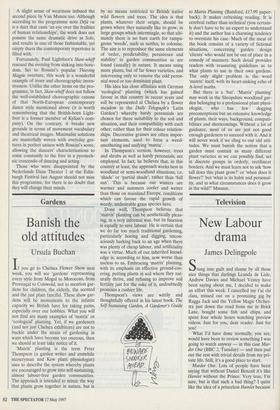Dance
Nederlands Dans Theater 2 (The Peacock Theatre)
Dutch stunners
Giannandrea Poesio
Theoretically, interpretation should be an essential element of theatre dance. Yet, as many dance-goers keep lamenting, the species of the 'thinking dancer', namely the artist capable of reading and conveying what is beyond the choreographic text, is almost extinct. The problem is felt particu- larly in relation to younger generations of dancers who appear to be more preoccu- pied with an accurate, often flashy, techni- cal rendition of the given steps than with an in-depth reading of the choreographer's intentions. Still, dancers should not be blamed, for their apparent lack of dramatic response reflects the taste of contemporary audiences who do not seem to understand that there is more to theatre dance than mere acrobatics.
It was a great relief, therefore, to attend last week's performance of Nederlands Dans Theater 2, for the young performers displayed stunning technical skill as well as powerful dramatic ability, demonstrating that there is still someone able to put some art into the part. Not an easy task, consid- ering the non-narrative nature of the works presented and their stylistic differences. Originally created in 1982, Song of the Way- farer, the first item on the programme, is a typical example of Jiri Kylian's choreogra- phy. Without being a literal translation of Mahler's song cycle, the dance develops through a series of images prompted by the musical undertones. The dramatic nuances of the various situations are embedded in the movement vocabulary which, as is often the case with Kylian's creations, stems from a calibrated combination of contemporary ballet solutions and an expressive, meta- phorical language of gesture. In other words, it is choreographic structure that suggests the moods of the work, providing the dancers with several interpretative pos- sibilities.
Although Hans Van Manen belongs to the same choreographic school as Kylian, generally referred to as the North-Euro- pean contemporary dance style, his cre- ations have often been characterised by distinctive abstract solutions that do not leave much space for the dancers' personal input. It was quite surprising, therefore, to be confronted with Solo, a tailor-made bravura piece for three male dancers. Cre- ated last January, Solo focuses on a youth- ful, humorous approach to Bach's music, highlighting the different, personal responses of three youngsters to a classical score. The Violin Suite No 1 in D Minor is used here to accompany frenzied, disco- dancing-like actions which clash vividly with such a 'sacred' music piece. The dis- crepancy, however, is only apparent, for an analysis of the choreographic solutions reveals an attentive reading of the score's phrasing. The result is an enticing explo- ration of three different personalities, con- veyed by diverse ways of dancing.
Different psychological portrayals, as well as an exploration of human relationships, isolation and sense of imprisonment occur also in Johan Inger's Sammanfall. The Swedish-born choreographer, however, has not managed to move away from the chore- ographic formulae he grew accustomed to, namely Kylian's ones, as a former member of Nederlands Dans Theater 1, the major company of which Nederlands Dans The- ater 2 is the 'training ground'. Despite some interesting theatrical solutions, including a haunting watchful big eye that dominates and controls the action, the dance lacks proper development resulting in a weary repetition of the choreographic images. IN. A slight sense of weariness imbued the second piece by Van Manen too. Although according to the programme note Deja vu is a duet that casts 'an eye over the frailties of human relationships', the work does not possess the same dramatic drive as Solo, and results in one of those fashionable, yet empty duets the contemporary repertoire is filled with.
Fortunately, Paul Lightfoot's Skew-whiff rescued the evening from sinking into bore- dom. Set to Rossini's popular Thieving Magpie overture, this work is a wonderful example of irony and choreographic inven- tiveness. Unlike the other items on the pro- gramme, in fact, Skew-whiff does not follow the well-established choreographic canons of that North-European contemporary dance style mentioned above (it is worth remembering that the British-born Light- foot is a former member of Kylian's com- pany). On the contrary, it breaks new grounds in terms of movement vocabulary and theatrical images. Minimalist solutions are masterfully woven with everyday ges- tures in perfect unison with Rossini's score, allowing the dancers' characterisations to come constantly to the fore in a pyrotech- nic crescendo of dancing and acting.
Those who were disappointed by the Nederlands Dans Theater 1 at the Edin- burgh Festival last August should not miss this programme, for there is no doubt that they will change their minds.



































































 Previous page
Previous page